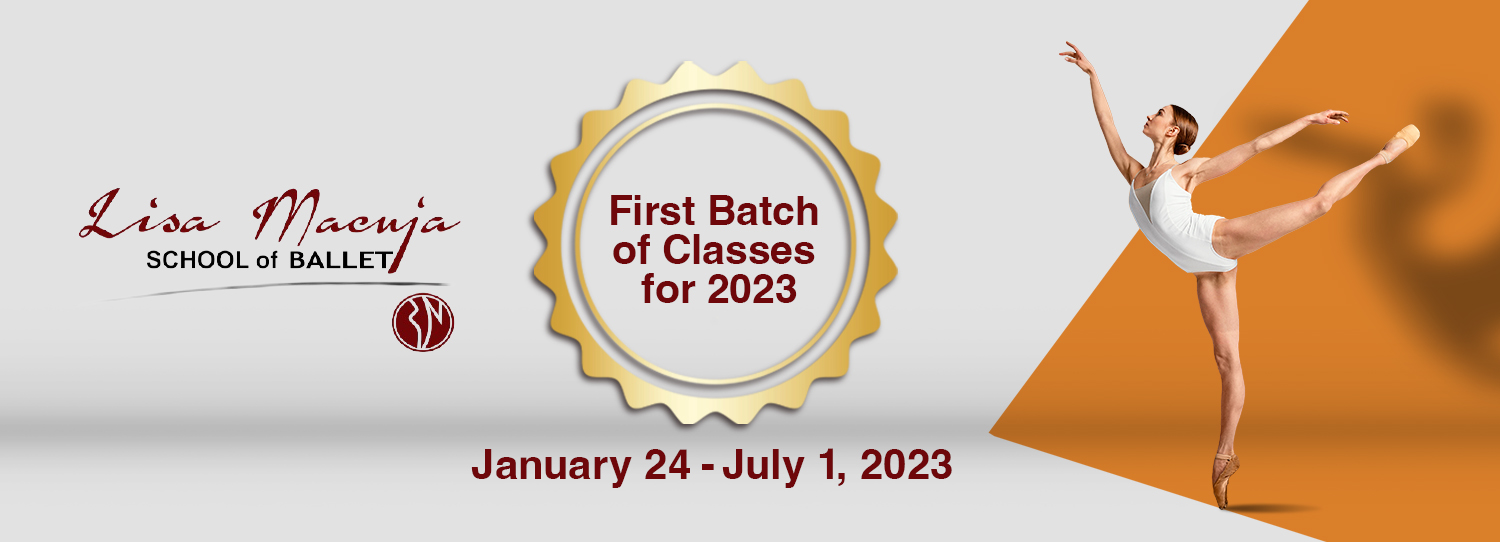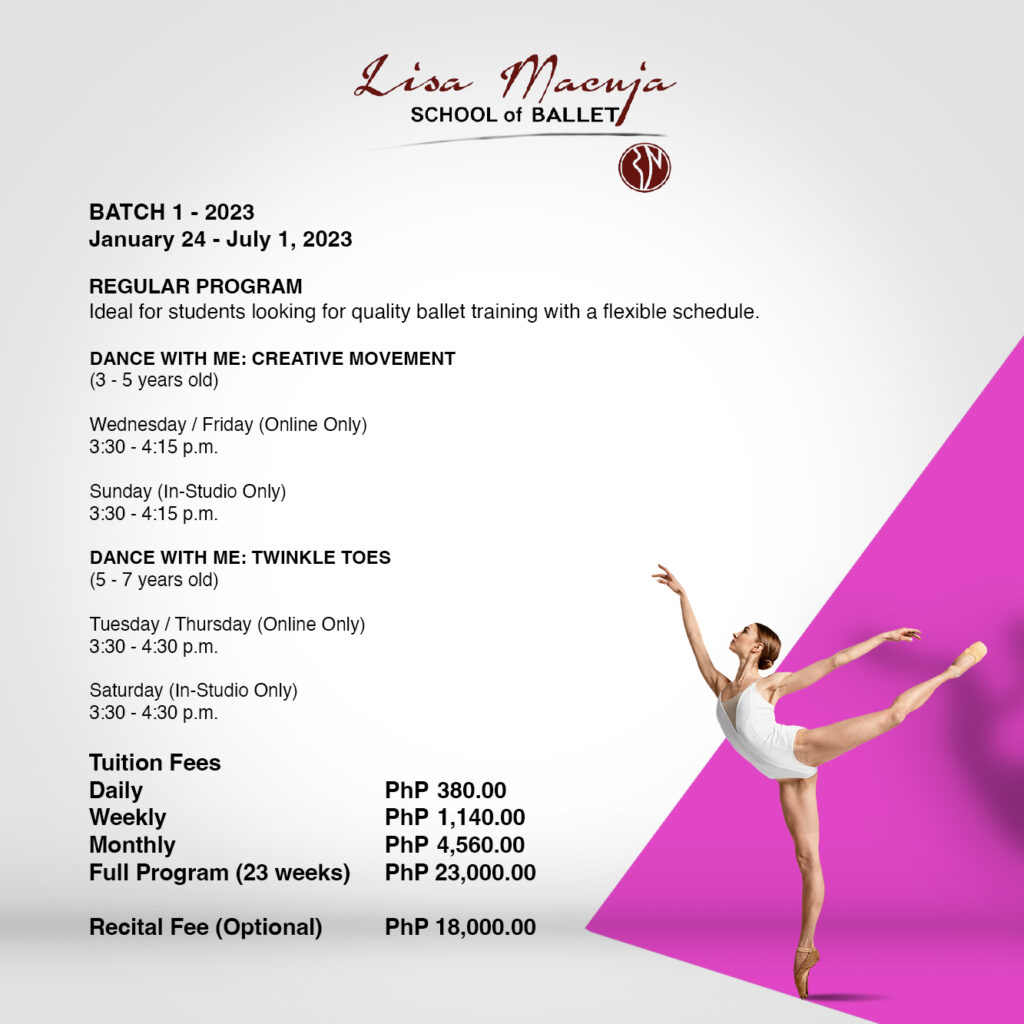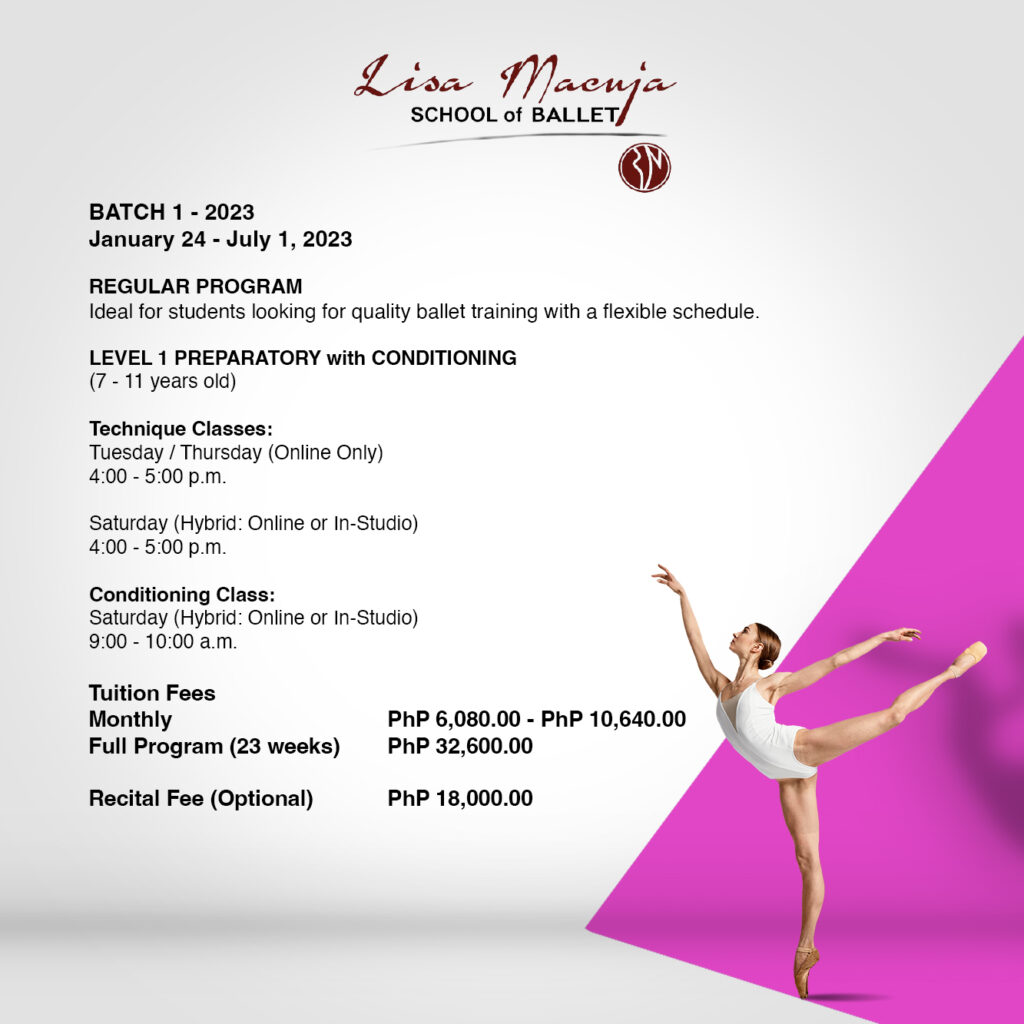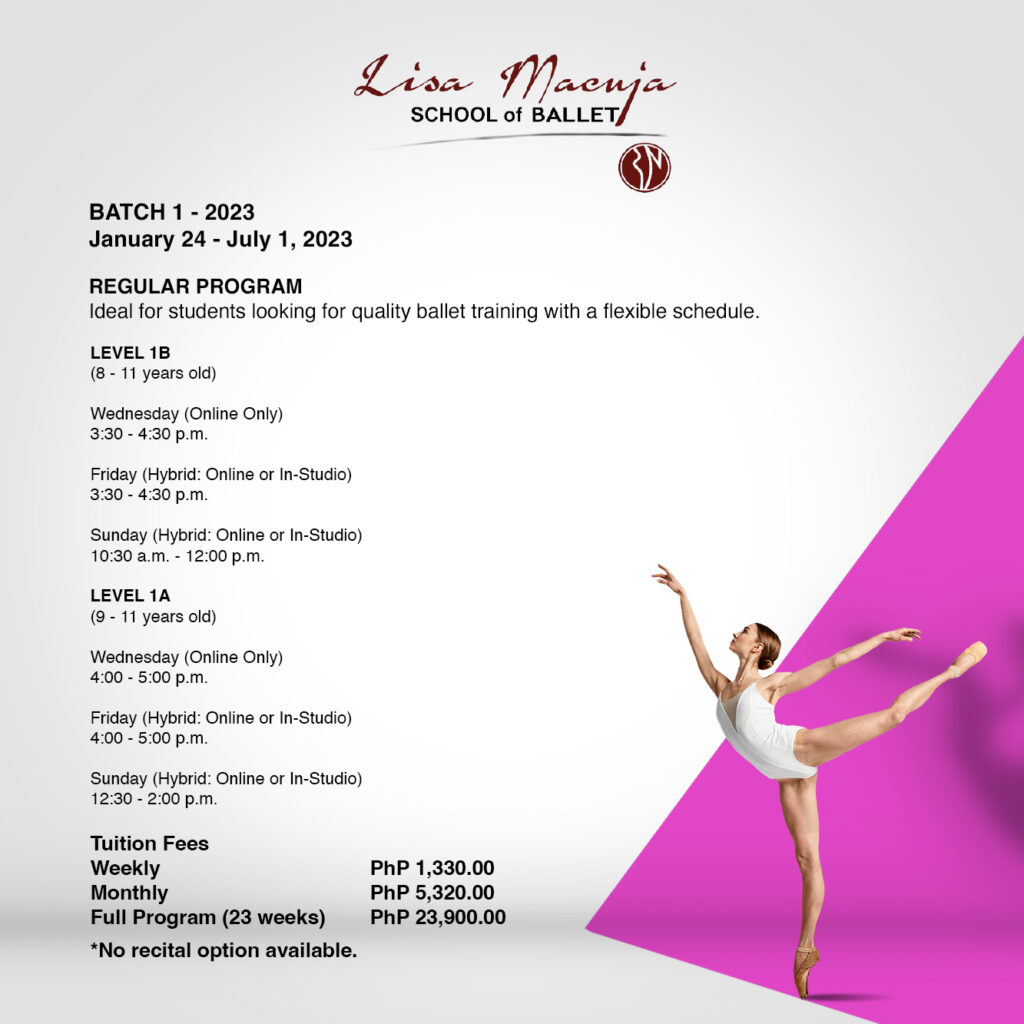
Regular Program
January 24 - July 1, 2023
The Regular Program is ideal for students looking for quality ballet training with a flexible schedule. All students are allowed to pick and choose their own dates.
I. Baby Ballet
The Baby Ballet levels are designed to instill the love of dance and provide creative modes of expression for children 3 – 7 years old.

A. Creative Movement (Dance with Me)
3 to 5 years old
Class is for 1 child and 1 older companion who is at least 12 years old.
This class is designed to create a shared experience between the child and a parent, older sibling, even a grandparent! A companion, at least 12 years old, is required to take the class with the child.
Students learn proper ballet techniques specially geared for their developing motor skills and coordination, rhythm, and musicality. Young students work with props or play materials to enhance learning and make the classes fun and engaging.
B. Twinkle Toes (Dance with Me)
5 to 7 years old
Class is for 1 child and 1 older companion who is at least 12 years old.
This class is designed to create a shared experience between the child and a parent, older sibling, even a grandparent! A companion, at least 12 years old, is required to take the class with the child.
Twinkle Toes is a creative ballet class that is the springboard for the Junior Levels. Students are introduced to the structure of classical ballet in a fun environment
II. Junior Levels
The Junior Levels will teach children between 7 – 11 years old the core fundamentals of classical ballet at the barre and center. Drills for coordination and movement are also emphasized.

A. Level 1 Preparatory With Conditioning
7 to 11 years old
No previous ballet training required. This is the level for complete beginners.
This level aims to establish the position of the body, head, arms, and legs through barre and center exercises. Barre exercises are done with both hands on and the body facing the barre.
Equal focus is placed on building the foundation for jumps as well as practicing coordination and movements.
The longer minimum enrollment commitment ensures that the student is prepared adequately for the higher levels.

B. Level 1B - Beginner
8 to 11 years old
With at least one year of classical ballet training.
In this level, the dance vocabulary introduced in the preparatory level is reinforced and is taken to the next level of difficulty. Barre exercises are done with just one hand on the barre and facing different directions; center exercises oriented to various corners of the room.
C. Level 1A - Advanced
9 to 11 years old
With at least two (2) years of classical ballet training.
This level focuses on the improvement of the coordination of the body, head, arms, and legs through barre, center, and jump exercises with progressive difficulty. Body strength is developed through increased tempos as well as higher and longer extensions. The feet and ankles are strengthened by practicing on half-pointe.
Basic pointe exercises are introduced at this level.
III. Middle Levels
The Middle Levels are structured to provide the student with the dance vocabulary and techniques to promote strength, stamina, and musicality.

A. Level 2 (With Pointe Training)
Minimum of two (2) years of classical ballet training is required for all levels; placement of student is the sole discretion of the school.
This is level transitions the student from the Junior to Middle Levels.
The exercises at the barre and center are done on demi-pointe to make the legs stronger and improve balance necessary for full pointe work. The foundations of turning, beats, hopping on pointes, and pirouettes are introduced. All students in this level are deemed ready to do beginner pointe.
Stage performance and variation training is begun with short waltz, polka, or mazurka pieces.
B. Level 2B - Beginner
(With Pointe Training)
Minimum of two (2) years of classical ballet training is required for all levels; placement of student is the sole discretion of the school.
At this level, more of the exercises are done on demi-pointe and full pointe in big poses to further develop strength and balance. More complicated coordination exercises are provided as the student is prepared to do big jumps and turns.
Choreography of classical variations and codas are incorporated in technique and pointe classes to prepare the students to tackle solo variation performances.
C. Level 2A - Advanced
(With Pointe Training)
Minimum of two (2) years of classical ballet training is required for all levels; placement of student is the sole discretion of the school. Must know how to dance in pointe shoes.
The focus of this class is on more advanced barre work as well as strengthening the legs and feet with more intensive pointe exercises. Center work includes turns, balances, and combinations; and preparation is started for elevating all jumps.
Choreography of classical variations and codas are incorporated in technique and pointe classes to prepare the students to tackle solo variation performances.
IV. Senior Levels
The Senior Levels cover two of the final three years of training of the Vaganova syllabus. Considered to be pre-professional levels, concepts, techniques, and combinations introduced are designed for serious students who have goals of pursuing careers in classical ballet.
These levels are exclusively taught by school directress and prima ballerina, Lisa Macuja Elizalde.

A. Level 3B
This level is the beginning level of the senior classes that are of pre-professional level; and works on the goals and dance vocabulary of year 6 of training in the Vaganova syllabus. More combinations in the barre and center are accomplished on half-pointe; turns, jumps, pointe work, and adagios are more complex.
Additional classes in variation, pointe, pas de deux (partnering) mime and contemporary ballet are encouraged for the serious student looking to join competitions or become professional in the future.
B. Level 3A / 4
3A is the second level in our senior classes that are in the pre-professional level; and uses the goals and dance vocabulary of year 7 training in the Vaganova syllabus.
More complex adagios are accomplished with the addition of big jumps; more technical difficulties are added to the turns in small and big positions with increased speed and number of revolutions; jumps are done with beats and turning; the combinations are now done with a more dancing flow and quality.
The continued development of the individual qualities of the student is given utmost importance.
Additional classes in variation, pointe, pas de deux (partnering), mime, and contemporary are encouraged for the senior student aspiring to join ballet competitions and becoming professional in the future.
Classes in variation, pointe, pas de deux (partnering) mime, and contemporary ballet are encouraged for the serious student looking to join competitions or become professional in the future.
ACCEPTED PAYMENT METHODS






Student Testimonials
Regular Program
Philippines
Certificate Program
Philippines
Yap En Yu
Regular Program
Malaysia



